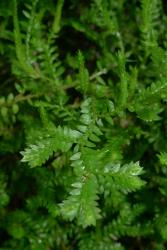Terrestrial (NZ) or rarely epiphytic (not NZ). Plants of varied habit, with an erect or prostrate main stem, giving rise to subsidiary branching systems; lacking a clearly defined rhizome, but erect species sometimes spreading by creeping basal branches; lacking scales. Roots (rhizophores) arising from axils of branches, dichotomously branched, of varying thickness, occurring throughout the length of prostrate stems, or arranged basally to support erect species. Main stems either far-creeping and sometimes scrambling or climbing, much-branched and of indefinite growth; or short-creeping, becoming erect with an unbranched stem giving rise to a frond-like branch-system of finite growth. Leaves spirally arranged, ligulate, undivided, with a single unbranched vein; leaf margins entire to minutely toothed or ciliate; leaves either all similar or of two kinds, those on the basal creeping stems often far apart, those on the ultimate branches closely inserted in four ranks. Strobili terminal on primary or ultimate branches, sometimes inconspicuous. Sporophylls similar to leaves but usually smaller, arranged in four ranks, monomorphic (NZ) or rarely dimorphic (not NZ). Sporangia solitary on adaxial surface of sporophyll, inserted just above the ligule, of two types variously arranged in the strobili. Heterosporous; megasporangia usually containing four megaspores; microsporangia containing more than 100 microspores. Megaspores trilete, pale brown or white, ridged around the equator and trilete scar, variously patterned on the surface, 200–600 µm in diameter; microspores trilete, yellow or orange-brown or red, variously patterned on the surface, 20–60 µm in diameter.
A family of one genus, Selaginella, and c. 750 species (Weststrand & Korall 2016).
Selaginellaceae have long been recognised as one of three isolated families within the Lycopodiopsida, distinguished by their terrestrial habit, delicate ligulate leaves, and heterosporous sporangia borne in strobili. The range of variation within the family has been summarised by Jermy (1990).
Selaginellaceae comprise terrestrial lycophytes bearing delicate, ligulate, and either monomorphic or dimorphic leaves with single unbranched veins. The stems are either prostrate, creeping and irregularly branching, or erect and forming a frond-like branching system. Sporangia are solitary on the adaxial surface of the sporophylls, which are aggregated into strobili. Plants are heterosporous with mega- and microsporangia variously arranged in the strobili, releasing mega- and microspores.
A large family found mainly in the tropics but with a few species in the temperate zones of both hemispheres. Indigenous species are present in Australia (Jermy & Holmes 1998), New Caledonia, Fiji and many other islands of the South Pacific, but none in New Zealand. One species fully naturalised, and two casual, in New Zealand.
| Category | Number |
|---|---|
| Exotic: Fully Naturalised | 1 |
| Exotic: Casual | 2 |
| Total | 3 |




